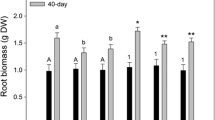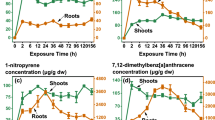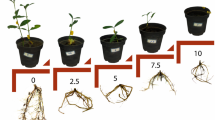Abstract
This study investigated the uptake and accumulation of polycyclic aromatic hydrocarbons (PAHs) in two mangrove species, Avicennia marina and Rhizophora mucronata. We tested the hypothesis that A. marina would absorb and accumulate more PAHs than R. mucronata. One-year old seedlings of both species were subjected to Bunker Fuel Oil 180 for 3 weeks, and the concentration of PAHs was analyzed by gas chromatography-mass spectrometry (GC/MS). The concentration of PAHs was significantly higher in A. marina than in R. mucronata. The major portion of the PAH pool was in roots (96% in A. marina, 98% in R. mucronata) compared to leaves. The dominant PAHs in roots of both species possessed two to three rings and included phenanthrene, anthracene, fluorene, and acenaphthene. In shoots, PAHs in A. marina included phenanthrene, chrysene, anthracene, acenaphthene, benzo[k+b]fluoranthene, pyrene, benzo[a] anthracene, and benzo[a] pyrene, while those in R. mucronata included phenanthrene, naphthalene, fluoranthene, fluorene, and acenaphthene. Phenanthrene was the dominant PAH in roots and shoots of both species. The greater susceptibility of A. marina appears to be due to its greater root length and specific root length, which permit more exposure to oil than R. mucronata. Other contributory factors include root anatomical characteristics such as larger air spaces, lower suberization of root epidermal cells, lower concentrations of polyphenols, tannins, lignin, and a less efficient antioxidative system. This study provides novel information on differences in the uptake and accumulation of PAHs in two contrasting mangrove species.




Similar content being viewed by others
References
Alkio M, Tabuchi TM, Wang X, Carmona CA (2005) Stress responses to polycyclic aromatic hydrocarbons in Arabidopsis include growth inhibition and hypersensitive response-like symptoms. J Exp Bot 56:2983–2994
Balke T, Bouma TJ, Horstman EM, Webb EL, Erftemeijer PLA, Herman PMJ (2011) Windows of opportunity: thresholds to mangrove seedling establishment on tidal flats. Mar Ecol Prog Ser 440:1–9
Barbier EB (2016) The protective service of mangrove ecosystems: a review of valuation methods. Mar Pollut Bull 109:676–681
Bashir M, Maradny A, Sherbiny M, Rasiq KT, Orif M (2017) Bio-concentration of polycyclic aromatic hydrocarbons in the grey mangrove (Avicennia marina) along eastern coast of the Red Sea. Open Chemistry 15:1–8
Burke MK, Raynal DJ (1994) Fine root growth phenology, production, and turnover in a northern hardwood forest ecosystem. Plant Soil 162:135–146
Chroma L, Mackova M, Kucerova P, Burkhard J, Macek T (2002) Enzymes in plant metabolism of PCBs and PAHs. Acta Biotechnol 22:35–41
De Ryck DJR, Roberta EMR, Schmitz N, Van der Stocken T, Di Nittoa D, Dahdouh-Guebasa F, Koedam N (2012) Size does matter, but not only size. Two alternative dispersal strategies for viviparous mangrove propagules. Aquat Bot 103:66–73
Friess DA (2016) Ecosystem services and disservices of mangrove forests: insights from historical colonial observations. Forests 7:183–199
Friess DA, Richards DR, Phang VXH (2016) Mangrove forests store high densities of carbon across the tropical urban landscape of Singapore. Urban Ecosyst 19:795–810
Gao Y, Zhu L (2004) Plant uptake, accumulation and translocation of phenanthrene and pyrene in soils. Chemosphere 55:1169–1178
Getter CD, Baca BJ (1984) A laboratory approach for determining the effects of oils and dispersants on mangroves. In: Allen TE (ed) Oil spill chemical dispersants: research, experience and recommendations. STP 840, American Society for Testing and Materials, Philadelphia, pp 5–13
Jagtap TG, Untawale AG (1980) Effect of petroleum products on mangrove seedlings. Mahasagar-804. Bull Natl Inst Ocean 13:165–172
Jiang S, Weng B, Liu T, Su Y, Liu J, Lu H, Yan C (2017) Response of phenolic metabolism to cadmium and phenanthrene and its influences on pollutant translocations in mangrove plant Aegiceras corniculatum (L.) Blanco (Ac). Ecotoxicol Environ Saf 141:290–297
Kang F, Chen D, Gao Y, Zhang Y (2010) Distribution of polycyclic aromatic hydrocarbons in subcellular root tissues of ryegrass (Lolium multiflorum Lam.). BMC Plant Biol 10:210–215
Ke L, Zhang C, Wong YS, Tam NFY (2011) Dose and accumulative effects of spent lubricating oil on four common mangrove plants in South China. Ecotoxicol Environ Saf 74:55–66
Khoddami A, Wilkes MA, Roberts TH (2013) Techniques for analysis of plant phenolic compounds. Molecules 18:2328–2375
Lewis M, Pryor R, Wilking L (2011) Fate and effects of anthropogenic chemicals in mangrove ecosystems: a review. Environ Pollut 180:345–367
Li F, Zeng X, Yang J, Zhou K, Zan Q, Lei A, Tam NFY (2014) Contamination of polycyclic aromatic hydrocarbons (PAHs) in surface sediments and plants of mangrove swamps in Shenzhen, China. Mar Pollut Bull 85:590–596
Lu ZQ, Zheng WJ, Ma L (2005) Bioconcentration of polycyclic aromatic hydrocarbons in roots of three mangrove species in Jiulong River Estuary. J Environ Sci (China) 17:285–289
Meudec A, Dussauze J, Deslandes E, Poupart N (2006) Evidence for bioaccumulation of PAHs within internal shoot tissues by a halophytic plant artificially exposed to petroleum-polluted sediments. Chemosphere 65:474–481
Naidoo G (2016) Mangrove propagule size and oil contamination effects: does size matter? Mar Pollut Bull 110:362–370
Naidoo G, Naidoo K (2016) Uptake of polycyclic aromatic hydrocarbons and their cellular effects in the mangrove Bruguiera gymnorrhiza. Mar Pollut Bull 113:193–199
Naidoo G, Naidoo K (2017a) Are pioneer mangroves more vulnerable to oil pollution than later successional species? Mar Pollut Bull 121:135–142
Naidoo G, Naidoo K (2017b) Ultrastructural effects of polycyclic aromatic hydrocarbons in the mangroves Avicennia marina and Rhizophora mucronata. Flora 235:1–9
Pi N, Tam NFY, Wu Y, Wong MH (2009) Root anatomy and spatial pattern of radial oxygen loss of eight true mangrove species. Aquat Bot 90:222–230
Proffitt CE, Devlin DJ, Lindsey M (1995) Effects of oil on mangrove seedlings grown under different environmental conditions. Mar Pollut Bull 30:788–793
Proisy C, Gratiot N, Anthony EJ, Gardel A, Fromard F, Heuret P (2009) Mud bank colonization by opportunistic mangroves: a case study from French Guiana using lidar data. Cont Shelf Res 29:632–641
Santos HF, Carmo FL, Paes JES, Rosado AS, Peixoto RS (2011) Bioremediation of mangroves impacted by petroleum. Water Air Soil Pollut 216:329–350
Shiri M, Rabhi M, Abdelly C, El Amrani A (2014) The halophytic model plant Thellungiella salsuginea exhibited increased tolerance to phenanthrene-induced stress in comparison with the glycophytic one Arabidopsis thaliana: application for phytoremediation. Ecol Eng 74:125–134
Sojinu OS, Wang JZ, Sonibare OO, Zeng EY (2010) Polycyclic aromatic hydrocarbons in sediments and soils from oil exploration areas of the Niger Delta, Nigeria. J Hazard Mater 174:641–647
Suprayogi B, Murray F (1999) A field experiment of the physical and chemical effects of two oils on mangroves. Environ Exp Bot 42:221–229
Thampanya U, Vermaat JE, Duarte CM (2002) Colonization success of common Thai mangrove species as a function of shelter from water movement. Mar Ecol Prog Ser 237:111–120
United States Environmental Protection Agency (2008) Polycyclic aromatic hydrocarbons (PAHs). Office of Solid Waste, Washington, DC
Wang Y, Tian Z, Zhu H, Cheng Z, Kang M, Luo C, Li J, Zhang G (2012) Polycyclic aromatic hydrocarbons (PAHs) in soils and vegetation near an e-waste recycling site in South China: concentration, distribution, source, and risk assessment. Sci Total Environ 439:187–193
Wang Y, Zhu H, Tam NF (2014a) Effect of a polybrominated diphenyl-ether congener (BDE-47) on growth and antioxidative enzymes of two mangrove plant species, Kandelia obovata and Avicennia marina, in South China. Mar Pollut Bull 85:376–384
Wang Y, Zhu H, Tam NFY (2014b) Polyphenols, tannins and antioxidant activities of eight true mangrove plant species in South China. Plant Soil 374:549–563
Wei S, Pan S (2010) Phytoremediation for soils contaminated by phenanthrene and pyrene with multiple plant species. J Soils Sediments 10:886–894
Wild E, Dent J, Thomas GO, Jones KC (2005) Direct observation of organic contaminant uptake, storage, and metabolism within plant roots. Environ Sci Technol 39:3695–3702
Zhang CG, Leung KK, Wong YS, Tam NFY (2007) Germination, growth and physiological responses of mangrove plant (Bruguiera gymnorrhiza) to lubricating oil pollution. Environ Exp Bot 60:127–136
Zhang M, Ahmad M, Lee SS, Xu LH, Ok YS (2014) Sorption of polycyclic aromatic hydrocarbons (PAHs) to lignin: effects of hydrophobicity and temperature. Bull Environ Contam Toxicol 93:84–88
Acknowledgements
The University of KwaZulu-Natal provided technical and other support.
Funding
The National Research Foundation, South Africa, provided financial support (grant number 9356, to G. Naidoo).
Author information
Authors and Affiliations
Corresponding author
Additional information
Responsible editor: Hongwen Sun
Rights and permissions
About this article
Cite this article
Naidoo, G., Naidoo, K. Uptake and accumulation of polycyclic aromatic hydrocarbons in the mangroves Avicennia marina and Rhizophora mucronata. Environ Sci Pollut Res 25, 28875–28883 (2018). https://doi.org/10.1007/s11356-018-2934-x
Received:
Accepted:
Published:
Issue Date:
DOI: https://doi.org/10.1007/s11356-018-2934-x




